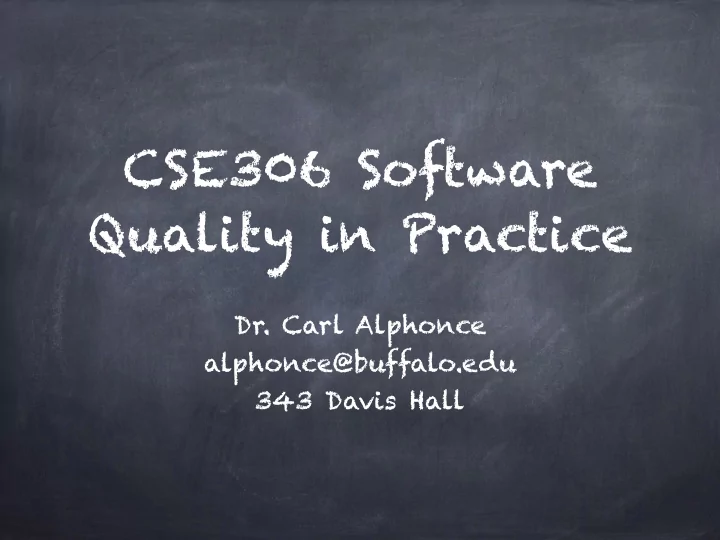

CSE306 Software Quality in Practice Dr. Carl Alphonce alphonce@buffalo.edu 343 Davis Hall
Announcements Syllabus: posted on website Academic Integrity PRE posted on website Team formation - how's it going? Grades will be in UBLearns
Compiler use /util/bin/gcc compiler use -std=c11 (you can use other options too) test on timberlake.cse.buffalo.edu (that’ s our reference system) If you modify your .cshrc file you can access the CSE installation of the compiler directly from the Bell 340 machines.
text, pg 8
1. Understand the requirements Is it a bug or a misunderstanding of expected behavior? Requirements will tell you.
2. Make it fail Write test cases to isolate bug and make it reproducible. This will increase confidence that bug is fixed later. These tests will be added to the suite of regression tests (“does today’ s code pass yesterday’ s tests?”)
3. Simplify the test case Ensure there is nothing extraneous in the test case. Keep it simple! Whittle it down until you get at the essence of the failure.
4. Read the right error message “Everything that happened after the first thing went wrong should be eyed with suspicion. The first problem may have left the program in a corrupt state. ” [p. 9]
5. Check the plug Don’ t overlook the obvious - things like permissions, file system status, available memory. “Think of ten common mistakes, and ensure nobody made them. ” [p. 9]
6. Separate fact from fiction “Don’ t assume!” Can you prove what you believe to be true? This is tough - it is hard to set aside your well-founded intuitions!
CONTINUING ON FROM LAST TIME
7. Divide and conquer
7. Divide and conquer Beware bugs caused by interactions amongst components. Develop a list of suspects (source code, compiler, environment, libraries, machine, etc) Each component alone may work correctly, but in combination bad things happen Can be especially tricky with multithreaded programs
8. Match the tool to the bug
8. Match the tool to the bug If all you have is a hammer … you’ll end up with a very sore thumb. Build a solid toolkit to give you choices. Use multiple tools/approaches (e.g. testing and debugging work better together than either along)
9. One change at a time
9. One change at a time Be methodical. If you make multiple changes at one you can't tease apart which change had which effect. With your list of suspects, document what you predict the outcome of a change will be. Document the changes you make, and the results. Did results match predictions?
10. Keep an audit trail
10. Keep an audit trail Make sure you can revert your code: use a code repository! This lets you back out changes that were not productive.
11. Get a fresh view
11. Get a fresh view Ask for someone else to have a look — but not before having done steps 1 - 10! Even just explaining the situation can help you better understand what is happening.
12. If you didn’ t fix it, it ain’ t fixed
12. If you didn’ t fix it, it ain’ t fixed Intermittent bugs will recur. If you make a change to the code and the symptom goes away, did you really fix it? You must convince yourself that the fix you applied really did solve the problem!
13. Cover your bug fix with a regression test
13. Cover your bug fix with a regression test Make sure the bug doesn’ t come back! Just because it worked yesterday doesn't mean it still works today. This is especially important in team environments where you are not the only person touching the code.
Essential tools compiler (e.g gcc) debugger (e.g. gbd) memory checker (e.g. memcheck) runtime profiler (e.g. gprof) automated testing framework (e.g. cunit) build tool (e.g. make, gradle) code repository (e.g. git) organization/collaboration tool (e.g. Trello) pad of paper / whiteboard
Classification of bugs Common bug (source code, predictable) Sporadic bug (intermittent) Heisenbugs (averse to observation) race conditions memory access violations (programmer) optimizations Multiple bugs - several must be fixed before program behavior changes - consider violating rule #9 "one change at a time"
uncertainty principle …the uncertainty principle, also known as Heisenberg's uncertainty principle, is any of a variety of mathematical inequalities[1] asserting a fundamental limit to the precision with which certain pairs of physical properties of a particle, known as complementary variables, such as position x and momentum p, can be known. https:/ / en.wikipedia.org/wiki/Uncertainty_principle
observer effect …the term observer effect refers to changes that the act of observation will make on a phenomenon being observed. This is often the result of instruments that, by necessity, alter the state of what they measure in some manner. https:/ / en.wikipedia.org/wiki/Observer_effect_(physics)
debugging tools instrument code during compilation instrumented code may behave differently than uninstrumented code in other words: the act of using a debugger may mask a bug, causing its symptoms to disappear, only to reappear when run without instrumentation
Essential tools compiler (e.g gcc) debugger (e.g. gbd) memory checker (e.g. memcheck) runtime profiler (e.g. gprof) automated testing framework (e.g. cunit) build tool (e.g. make, gradle) code repository (e.g. git)
Recommend
More recommend